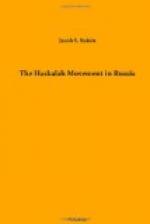Those, therefore, who disdained conversion allied themselves with the secret organizations. “The torrent which had been dammed up in one channel rushed violently into another.” A Hebrew monthly, Ha-Emet (Truth, Vienna, 1877), devoted to the cause of communism, was started by Aaron Liebermann ("Arthur Freeman"), in which, in the language of the oldest and greatest socialists, the doctrines of Karl Marx were inculcated among the Hebrew-reading public. The more completely Russified element took a leading part in the activities of the Narodnaya Volya (Rights of the People), propagating socialism among the Russian masses, either by word of mouth or as editors and coworkers in the “underground” publications. Not a few went to Berlin, where, though opulent, they sought employment in factories, the better to disseminate socialism among the working classes. Others, like Aaronson, Achselrod, Deutsch, Horowitz, Vilenkin, and Zukerman, fled to Switzerland, whence, under the assumed names of Marx, Lassalle, Jacoby, etc., or united in a League for the Emancipation of Labor, they directed the socialistic movement in Russia.[25] Chernichevsky’s What to Do, Gogol’s Dead Souls, Turgenief’s Virgin Soil and Fathers and Sons, the doctrines of Pisarev and Bielinsky, and of the other writers who then had their greatest vogue, were eagerly read and frequently copied by Jewish young gymnasiasts and passed on to their Christian schoolmates. The revolutionary spirit seized on men and women alike. Women left their husbands, girls their devoted parents, and threw themselves into the swirl of nihilism with a vigor and self-sacrifice almost incredible. When a squad of police came to disperse the crowd clamoring for “land and liberty” in front of the Kazanskaya Church in St. Petersburg, a Jewish maiden of sixteen, taking the place of the leader, inspired her comrades with such enthusiasm that the efforts of the police were ineffectual.[26] By 1878, Russia became honeycombed with secret societies. It fell into spasms of nihilism. One general after another was assassinated. Attempts were made to wreck the train on which the czar was travelling (1879) and blow up the palace in which he resided (1880). Finally, on March 13, 1881, after many hairbreadth escapes, the carefully laid plans of the revolutionists succeeded, and the Liberator Czar was no more.
Thus was the deep-rooted yearning for enlightenment finally let loose, and the gyves of tradition were at last removed. The Maskilim of the “forties” and “fifties” were antiquated in the “sixties” and “seventies.” They began to see that the fears of the orthodox and their denunciations of Haskalah were not altogether unfounded. A young generation had grown up who had never experienced the strife and struggles of the fathers, and who lacked the submissive temper that had characterized their ancestors. Faster and farther they rushed on their headlong way to destruction, while the parents sat




